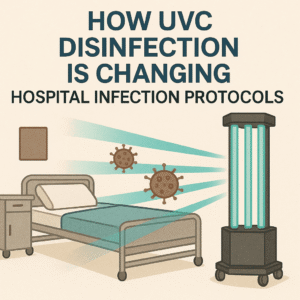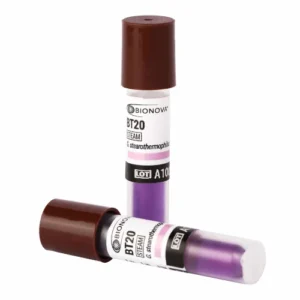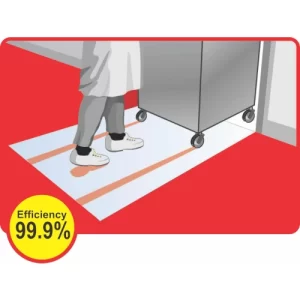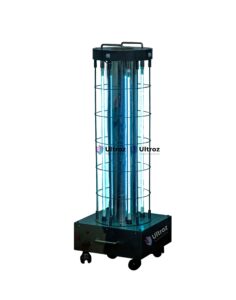In the relentless battle against hospital-acquired infections (HAIs), healthcare systems are constantly evolving. While traditional sterilisation and chemical disinfection methods have long been the backbone of hospital hygiene, a powerful new player is reshaping infection control protocols — UVC disinfection.
From operating rooms to ICUs, UVC (ultraviolet-C) technology is being adopted by hospitals worldwide to enhance surface and air disinfection. But what makes UVC so effective, and why are infection control teams embracing it as a standard part of protocol? Let’s explore deeper.
What Is UVC Disinfection?
UVC disinfection uses short-wavelength ultraviolet light to kill or inactivate microorganisms. By disrupting the DNA and RNA of bacteria, viruses, and fungi, UVC light renders them unable to replicate — effectively neutralising the threat.
Unlike UV-A and UV-B rays from the sun, UVC rays do not reach the Earth’s surface naturally. However, when artificially generated, they become potent tools for disinfection in sensitive environments like hospitals.

Why Hospitals Are Turning to UVC Disinfection
1. Enhanced Effectiveness Against Superbugs
HAIs caused by multi-drug resistant organisms (MDROs) like MRSA, VRE, and C. difficile have posed growing challenges. UVC disinfection provides an additional layer of protection, especially in high-touch areas where chemical wipes might miss spots.
2. Faster Turnaround Times
Manual cleaning can be labour-intensive and time-consuming. UVC systems can disinfect a standard patient room faster, allowing for quicker room turnover and better patient flow without compromising safety.
3. Consistent, Contactless Disinfection
Unlike human cleaners who may unintentionally skip surfaces, UVC systems offer consistent disinfection every cycle. Automated UVC robots and stationary units eliminate human error, reaching nooks and corners often overlooked during manual cleaning.
4. Chemical-Free and Environmentally Friendly
UVC light is a dry and residue-free method of disinfection. It reduces the hospital’s dependence on harsh chemical agents and lowers the environmental impact over time, making it a sustainable solution for large facilities.
Integrating UVC into Hospital Protocols
Hospitals are not replacing their existing cleaning routines entirely. Instead, UVC disinfection is being integrated as a complementary step to manual cleaning.
A common approach is the “double-hit method”: manual cleaning followed by a cycle of UVC irradiation. This ensures the physical removal of debris before UVC is deployed to kill remaining pathogens on surfaces and in the air.
Hospital infection control teams are also defining specific UVC deployment protocols — determining where, when, and how long UVC units should be used, based on the risk profile of different wards.
Key Areas of UVC Deployment
- Operating Theatres: High-risk zone for contamination; UVC is used after every procedure.
- ICUs and Isolation Wards: To control the spread of infectious pathogens.
- Emergency Rooms: High patient turnover and unpredictable exposure make UVC a valuable disinfection tool.
- CSSDs (Central Sterile Services Departments): UVC is used in conjunction with sterilisation logs and indicators to ensure instrument safety.
The Role of Portable UVC Disinfection Units
The recent rise in compact, mobile UVC disinfection units has further accelerated adoption. These units can be wheeled into any room, programmed remotely, and used with motion sensors for safety.
Products like Ultroz UVC Disinfection Units by Miracle Industries are gaining traction in India and abroad for their:
- High-efficiency germicidal lamps
- Motion sensor safety features
- Fast disinfection cycle times
- Zero chemical residue
Hospitals now have the ability to target disinfection wherever and whenever needed, improving responsiveness and overall hygiene standards.
Safety Considerations
While UVC is powerful, it can be harmful to human skin and eyes with direct exposure. Hence, protocols must ensure that disinfection cycles are run only in unoccupied rooms. Many systems include:
- Motion detectors to pause operation when movement is sensed
- Remote-controlled operation
- Protective enclosures or curtains
- Training staff on the safe use of UVC disinfection systems is a critical part of successful implementation.
Measurable Impact: Reducing HAIs
Early studies and field reports indicate that hospitals implementing UVC disinfection see a huge reduction in HAIs, depending on usage frequency and targeted areas. This is especially valuable in a country like India, where infection control standards are under increasing scrutiny.
UVC’s ability to disinfect both air and surface is helping create safer patient environments, reduce cross-contamination, and protect healthcare staff from secondary exposure.
Looking Ahead: The Future of Hospital Hygiene
With the continued rise in antimicrobial resistance and global pandemics, hospitals must go beyond traditional methods. UVC disinfection is no longer just a futuristic solution—it’s becoming a standard across modern hospitals.
Hospitals that invest in UVC disinfection technology are demonstrating leadership in patient safety, operational efficiency, and environmental responsibility.
For hospitals looking to adopt UVC disinfection systems, ensure the units meet international safety certifications, and partnering with experienced suppliers like Miracle Industries, offers advanced UVC disinfection products tailored for healthcare environments.
Frequently Asked Questions
Q1: Is UVC disinfection safe for hospital use?
Yes, when used properly and in unoccupied rooms, UVC disinfection is safe. Most systems include motion sensors and auto shut-off mechanisms to avoid accidental exposure.
Q2: Can UVC replace traditional chemical disinfection?
No, UVC is a complementary method. It enhances manual cleaning efforts and is most effective when used after physical cleaning has been done.
Q3: How long does UVC disinfection take?
UVC disinfection time varies depending on several factors depending on the size of the room and the power of the UVC unit.




